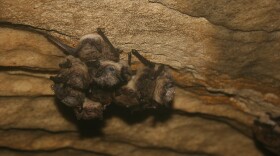Bats in New Hampshire have been struggling with White Nose Syndrome for the past few years. So we sat down with Wildlife Biologist Emily Preston from NH Fish and Game and Endangered Species Biologist Susi von Oettingen from U.S. Fish and Wildlife Service to find out how they’ve been faring recently.
Obviously, bats are really important in our eco-system because they are the greatest predator of nighttime insects. As von Oettingen explained, NH hosts eight species of bats (among them: Little brown bat, Long-eared bat, Tri-colored bat, Small-footed bat, Big-brown bat), so that adds up to a lot of insects consumed.
Bats start migrating at different times throughout the fall. In most cases, the females migrate shortly after mating, while the males stick around a little longer. But migration patterns also vary among and within species. Some are long-distance migrants which will fly as far south as the southern U.S., and some species are short-distance migrants, preferring to spend the cold months inside caves ("hibernacula") in New Hampshire, New York, Vermont, etc.
The Big-brown bat and Little-brown bat are the two most familiar bats in the state. These are the ones you’ll see skittering through your back yard on a summer night, or roosting in your eaves, attic or barn. Preston said that U.S. Fish and Wildlife Services has documented a 90-percent decline in Little-brown bat populations.
A European Invasion
Preston explained that WNS is a fungus that originated in Europe and somehow it found its way here. Once here, because it’s an exotic species and no there’s existing entity to keep it in check, it took off.
European bats seem to be living with WNS. It could be that they went through a similar situation hundreds of years ago, though there is no documentation of this. So it’s possible to extrapolate that North American bat populations will come through this. So the bats that survive WNS will become the seed population for what will become the bats of New England in the future. A population bottleneck like this is not uncommon, it’s part of the adaptive process that fuels evolution.

But what traits do the bats surviving WNS have that allowed them to survive? Short answer is: Nobody Knows. Preston referenced some data from Pennsylvania: a group of biologists had tagged some bats before WNS struck and have been checking up on them over the course of the crisis. The surviving bats seem to be consuming more insects before retiring to the hibernacula and so have larger stores of fat. So that’s one theory.
Bringing Bats Back from the Brink
There has been much discussion over the years about how we (humans) can help our besieged mammalian cousins. Since WNS is a fungus, couldn’t we treat the caves with some sort of antifungal, but a blanket response could end up doing more harm than good by killing off other bacteria/fungus that are part of the complex cave ecosystem. Inoculating the bats has also been considered, but catching individual bats is a difficult and time consuming process. Their sonar is incredibly sensitive and they can easily avoid nets or fly around a cloud of “medicine mist”.
There are small things we can do to help. If you’re comfortable living with bats in your attic, eaves or barn, leave them be. Or you could put up a bat house. Von Oettingen put one up in her yard in a hot, sunny place and had nineteen bats living there by the end of the summer.
"It's going to take hundreds of years for a rebound."
But perhaps we don’t need to “do” anything. Nature often seeks equilibrium, as with the European bats which seem to be living with the fungus. The few New Hampshire bats that are surviving this epidemic are passing whatever adaptation that has helped them to survive on their pups. So, potentially, we could look back on this situation from some future date and we’ll have healthy bat populations. Preston said it could take hundreds of years for such a rebound. Hundreds of years? She explained that bats, like other long-lived mammals, don’t produce many offspring, usually just one or two pups per year. Considering normal mortality rates, it will take a good long while for bats to again reach their pre-WNS population.










